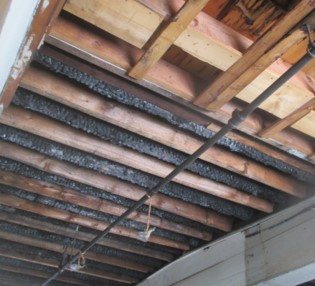Signs of Overstressed Wood Framing
By Brian Ki, P.E.
Most of New Hampshire and Massachusetts homes have been constructed using wood framing for floors, walls and roofs. The material is readily available and generally inexpensive when compared to other materials, such as steel or masonry. Just like any other material, wood has its own structural properties and limits to how much forces, or stress, it can handle.
Below is a quick list of signs that your wood framed building might be overstressed…
- Cracked/Twisted Members – The obvious. If wood is cracked, twisted, or significantly deformed, it is prone to stay that way. This includes damages from fire and even wood boring insects/pests. Any cracks or deformities in wood members will permanently affect its performance and often need to be repaired immediately.

- Excessive Sag/Deflection – The sag, or deflection, in a beam is a result of the building’s loads causing the material to flex. It is often dependent on the loads applied, span of the member, and its material properties. Longer, wood beams, joists, and rafters tend to have larger deflections.
- Fasteners – Sometimes the fasteners (i.e. nails, screws) may tell signs of an overstressed wood member. Gaps between two nailed members indicates one may be pulling away from the other. Bent, or deformed fasteners also indicate that the structural member may be overstressed or, at a minimum, not fastened properly.
- Overstressed Supports – Any structural member must transfer its loads to the foundation. Often horizontal members, such as beams and joists, are supported by vertical posts, or columns. If the “bearing length”, or length of the horizontal member sitting directly on the vertical post, is not properly accounted for, you may see the horizontal beam start to embed the post within it.
If you feel that your home may be experiencing some of the signs listed above (or maybe one that is not mentioned), feel free to give Team Engineering a call today. Our licensed Professional Engineers can assess the situation and design the proper repair so it won’t happen again.
More Articles From...
| This Category | Engineered Consultations, Home Repairs, Residential Engineering, Structural Engineering, Uncategorized |
| This Author | Brian Ki, P.E. |
